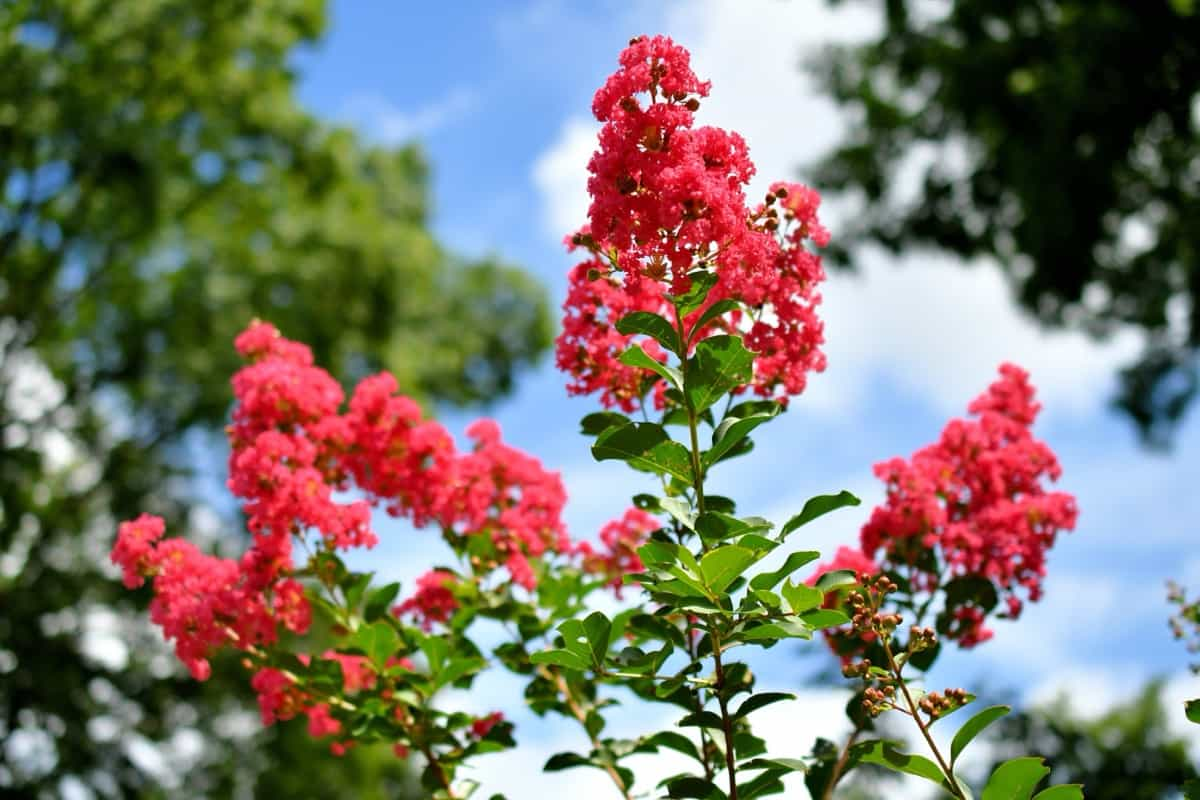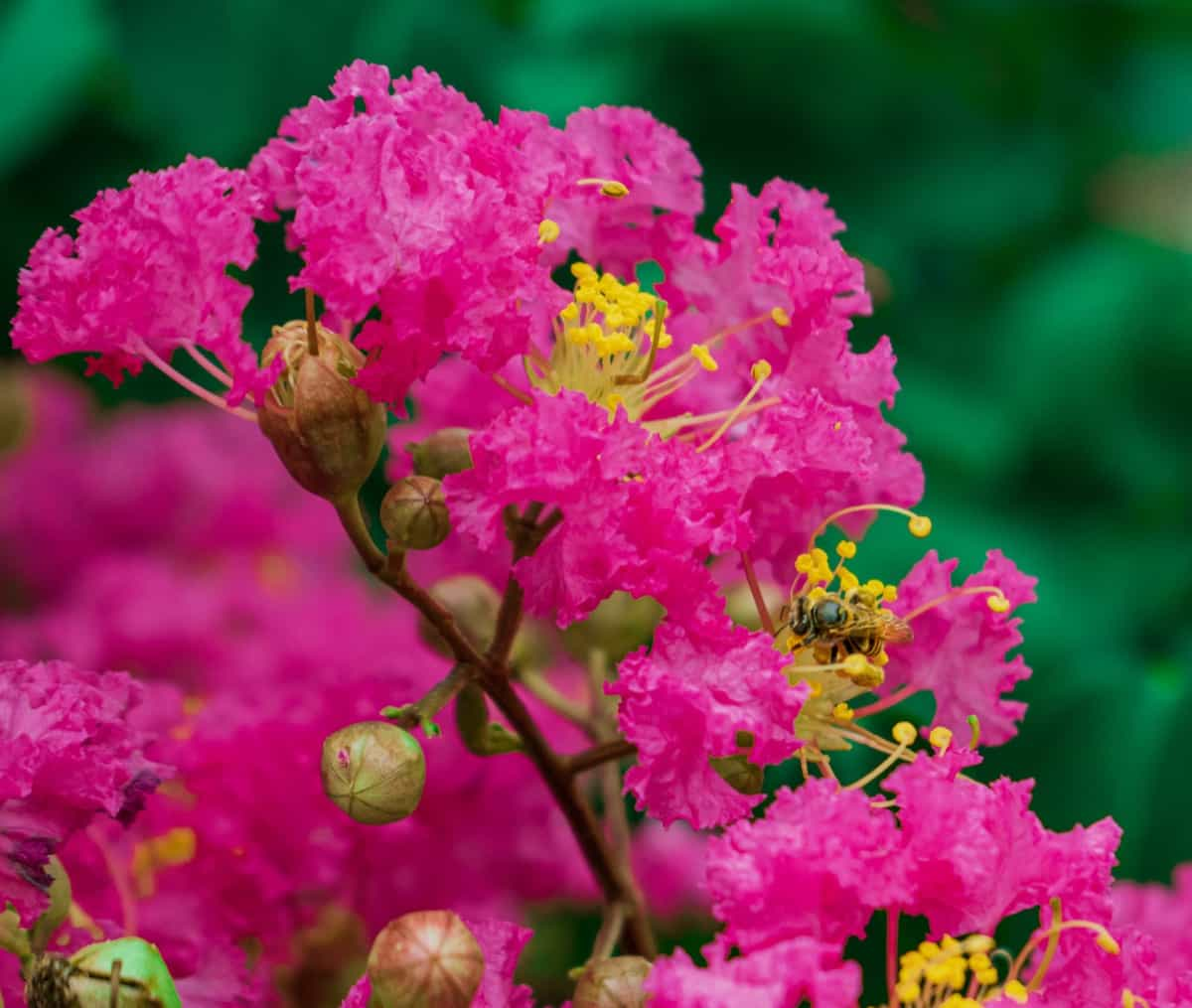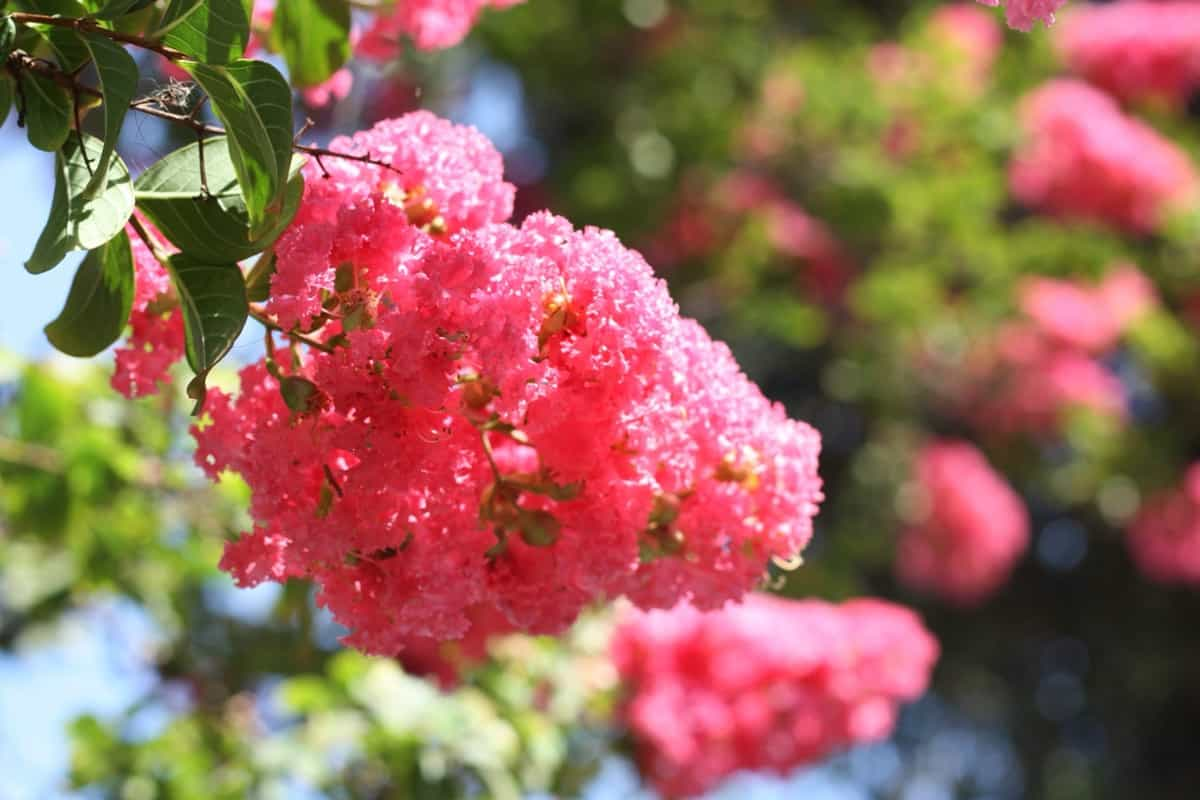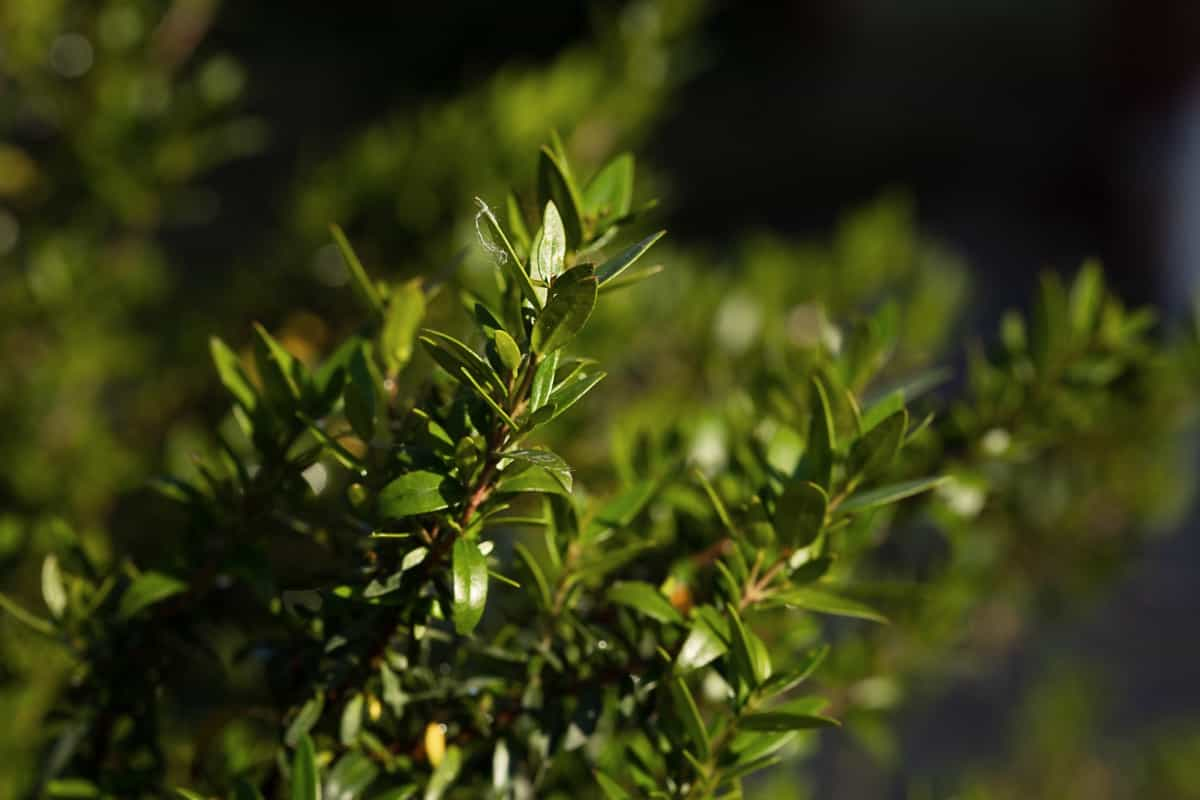Crape Myrtle trees are beautiful flowering trees that add beauty to any landscape. These versatile trees come in various sizes and colors, making them popular for landscapers. One of the standout features of Crape Myrtle trees is their stunning summer blooms. From vibrant pinks and purples to delicate whites, these flowers create an eye-catching display that can’t be ignored. In addition to their beauty, Crape Myrtles are drought-tolerant and relatively low-maintenance once established.

| Name | Crape Myrtle |
| mATURE SIZE | 3 to 20 feet tall |
| Sun Exposure | full |
| Soil pH & Type | 5 to 6.5, Well-drained |
| Plant Type | Deciduous tree / large shrub |
How to Grow Crape Myrtle Trees
Introduction to Crape Myrtle Trees
Crape Myrtle trees have become popular in many parts of the world for their stunning blooms and attractive bark. One of the reasons why Crape Myrtle trees are so beloved is because of their long-lasting and vibrant flowers. Depending on the variety, these flowers can range from shades of pink, purple, red, white, and even bicolors. In addition to their stunning flowers, Crape Myrtle trees also feature attractive peeling bark that adds visual interest even when not in bloom.
The smooth grayish-brown bark develops into mottled patches as it ages, providing an interesting texture to the tree’s overall appearance. What makes Crape Myrtles particularly appealing is their versatility. They come in various sizes, ranging from dwarf varieties suitable for containers or small gardens to larger ones that make excellent shade trees or privacy screens. This means there’s a perfect size for every garden space.
Choosing the Right Crape Myrtle Variety for Your Garden
Choosing the right Crape Myrtle variety for your garden can be exciting. First, think about the size of your garden and how much space you have available. Consider each variety’s mature height and spread and ensure it will fit well in your space. Next, think about the desired color of blooms. Crape Myrtles offers a stunning array of flower colors, including pink, red, purple, white, and even bi-color options.
Think about what will complement your existing landscape and bring beauty to your garden throughout the growing season. Another factor to consider is the length of bloom time. Some varieties have shorter blooming periods, while others have extended seasons with flowers lasting several months. Choose a variety that aligns with your preferences and desired visual impact.
Understanding the Ideal Growing Conditions for Crape Myrtle Trees
Crape Myrtles thrive best in full sunlight. They require at least six hours of direct sunlight daily to produce those stunning flowers. So, when selecting a planting spot, choose an area that receives ample sunshine throughout the day. Well-draining soil is crucial for Crape Myrtles’ success.
In case you missed it: How to Grow Crabapple Trees: A Guide Planting, Winter Care, and Harvest

These trees prefer slightly acidic soils with good drainage capabilities. Avoid heavy clay or compacted soils that can hinder root development and lead to waterlogging issues. Proper watering is equally important for healthy Crape Myrtle growth. While they are drought-tolerant once established, regular deep watering during dry spells will help maintain their vigor and enhance blooming.
Selecting and Preparing the Planting Site for Crape Myrtles
Selecting the perfect planting site for your Crape Myrtle trees is crucial to their overall health and growth. Before you start digging, take some time to carefully consider a few key factors that will contribute to their success. Evaluate the amount of sunlight the potential planting site receives. Crape Myrtles thrive in full sun conditions, so choose an area with at least 6-8 hours of direct sunlight daily. This will ensure vibrant blooms and strong tree structure.
Next, assess the soil quality. Crape Myrtles prefer well-draining soil with a slightly acidic pH between 5.0 and 6.5. Avoid areas with heavy clay or poorly drained soil, which causes root rot and other issues. Additionally, consider the size and spacing requirements of your chosen Crape Myrtle variety. These trees come in various sizes, ranging from dwarf cultivars suitable for small gardens to larger varieties better suited for open landscapes or park settings.
Step-by-Step Guide to Planting Crape Myrtle Trees
Planting Crape Myrtle trees is best done during the early spring or fall. This allows for optimal root establishment and reduces stress on the tree. Before planting, it’s important to prepare the soil properly. Crape Myrtles prefer well-draining soil with a slightly acidic pH level. Loosen the soil in a wide area around where you plan to plant, removing any weeds or grass.
Dig a hole and carefully remove your Crape Myrtle from its container or burlap sack, being mindful not to damage any of its roots. Place it in the hole’s center, ensuring it sits at ground level or slightly above. Backfill the hole with soil while gently pressing down to eliminate air pockets.
Watering Techniques for Healthy Crape Myrtle Growth
Proper watering plays a key role in the healthy growth rate of Crape Myrtle trees. Rather than shallow, frequent watering, giving your Crape Myrtles a deep soak every 7-10 days is best. Water your Crape Myrtles in the early morning or late afternoon when temperatures are cooler. This allows moisture to penetrate the soil before evaporation occurs. Regularly check soil moisture levels by inserting a finger into the ground near the tree’s drip line. If it feels dry at a depth of 2-3 inches, it’s time for another watering session.
Propagating Crape Myrtles: Methods and Tips for Success
One popular method is through stem cuttings. Take 4–6-inch cuttings from the current year’s growth in early spring or late winter. Remove lower leaves from the cutting and dip them in rooting hormone before planting them in well-draining soil or a propagation mix. Keep the soil moist but not soggy, and provide indirect sunlight until roots form.
In case you missed it: How to Grow Hawthorn Trees: Propagation, Planting, Pruning, and Winter Care

Another method is layering, which involves bending a flexible branch to touch the ground and burying a section under the soil. The buried part will develop roots while still attached to the parent plant. Once rooted, you can separate it from the main plant. Grafting is another option for propagating Crape Myrtles. This technique combines two plants – usually by attaching a desired variety onto an established rootstock – to create one tree with desirable traits.
Transplanting Crape Myrtle Trees: Guidelines for a Smooth Transition
First things first, timing is key when it comes to transplanting. The best time to do so is during the dormant season. This allows the tree to adjust and establish its roots in its new location without the stress of hot summer temperatures. Before digging up your Crape Myrtle, make sure you have prepared the new planting site beforehand. Choose a place that gets ample sunlight and has well-drained soil.
Dig a hole slightly larger than your tree’s root ball, ensuring enough space for the roots to spread out comfortably. Gently remove the tree by digging around the perimeter of the root ball and lifting it out of the ground. Remember not to damage roots during this process; they are essential for nutrient uptake and water absorption. Once removed, carefully transfer the tree into its new planting hole.
Position it to sit at approximately the same depth as before – too deep or too shallow can hinder its growth. Backfill with soil around the root ball, gently firming it down as you go. After transplanting, give your Crape Myrtle a good watering to help settle any air pockets in the soil and ensure adequate moisture levels for root establishment. Apply a layer of mulch around the tree’s base, but keep it several inches away from touching directly against the trunk.
Fertilizing Crape Myrtle Trees: Dos and Don’ts
Proper fertilization is essential for your Crape Myrtle trees’ healthy growth and vibrant blooms. Look for a fertilizer with equal nitrogen, phosphorus, and potassium (NPK). This will promote overall plant health. Fertilize your Crape Myrtles just before they start their new growth phase in early spring. This will give them a nutrient boost as they begin their active growth. Always read and follow the instructions on the fertilizer packaging regarding application rates and timing.
After applying fertilizer, water your trees thoroughly to help nutrients penetrate the soil. Applying too much fertilizer can cause excessive leafy growth at the expense of flowers. It can also burn or damage roots. Avoid fertilizing late in summer or fall, as this may encourage new growth that won’t have enough time to harden off before winter arrives. High-nitrogen fertilizers promote foliage growth but can inhibit flower production.
Pruning Crape Myrtles: Best Practices for Optimal Shape and Size
Regarding Crape Myrtle tree pruning, a few key practices can help you achieve the optimal shape and size for these beautiful plants. Pruning enhances their overall appearance and promotes healthier growth and abundant blooms. Timing is crucial when pruning Crape Myrtles. It’s best to prune them during late winter or early spring before new growth begins.
In case you missed it: 14 Best Trees for Fall Colors: Top List Composed

This allows for better healing of any cuts made and encourages vigorous regrowth. Selectively prune back long or leggy branches to maintain an attractive shape and encourage more flowers. Aim to create an open vase-like structure with several main stems emerging from the tree’s base.
Preventing and Managing Common Pests and Diseases in Crape Myrtles
One of the most common pests that affect Crape Myrtles is aphids. These tiny insects feed sap of new growth, causing leaves to curl and distort. To combat them, use a strong stream of water from a hose to dislodge them or apply insecticidal soap as needed. Another pesky critter to watch out for is the Crape Myrtle bark scale. These small white scales attach themselves to the branches and trunks of the tree, excreting honeydew that attracts sooty mold. The best way to manage this infestation is by applying horticultural oil in early spring before new growth appears.
Fungal diseases like powdery mildew can also plague Crape Myrtles. This white powdery substance on leaves inhibits photosynthesis and weakens the tree over time. To prevent its spread, ensure good air circulation around your trees by pruning any crowded branches or foliage. Leaf spot disease is another common issue in these trees. Left untreated, it manifests as dark spots or leaf lesions, leading to premature defoliation. Regularly inspect your trees for signs of leaf spot and promptly remove any infected leaves or branches.
Winter Care Tips for Crape Myrtle Trees
As the temperature drops and frost settles in, it’s important to take proper care of Crape Myrtle trees during winter. While these hardy trees can withstand cold weather, a little extra attention can ensure their health and vitality come springtime. Providing adequate moisture for your Crape Myrtles during the winter is crucial. This means watering deeply before the ground freezes to ensure they have enough hydration throughout the dormant period.
Next, consider adding mulch around the base of your Crape Myrtle trees. Opt for organic materials like wood chips or shredded bark, applying a thick layer but keeping it away from direct contact with the trunk. Regarding pruning, hold off until late winter or early spring when new growth emerges. Pruning too early can stimulate fresh growth that is vulnerable to frost damage. When pruning, focus on removing dead or diseased branches and thinning out crowded areas for better air circulation.
Enhancing Flowering and Colorful Blooms in Crape Myrtles
Crape Myrtle trees are known for their stunning blooms, adding color to any garden. Sunlight is essential for optimal blooming. Ensure your Crape Myrtle trees receive at least six hours of direct sunlight daily. This will encourage healthy growth and abundant blossoms. Proper pruning plays a significant role in enhancing flowering. Prune your Crape Myrtles during late winter or early spring before new growth begins. Remove any dead or diseased branches while maintaining the tree’s natural shape.
Regular fertilization is crucial for promoting colorful blooms. Use a balanced fertilizer specifically formulated for flowering plants during early spring and mid-summer. Additionally, adequate water is necessary but not excessive, as it can promote leafy growth rather than blooming. Water deeply once or twice weekly, allowing the soil to dry out between watering sessions.
In case you missed it: The Best Plants for USDA Zone 9: Top Trees, Flowering, Perennial, Drought-Tolerant, and Container Plants

Furthermore, mulching around the base of your Crape Myrtle trees helps retain moisture and regulate soil temperature while preventing weed growth that could compete with nutrients. Consider planting companion plants that complement your Crape Myrtles’ colors, such as salvia or butterfly bush. These additional bursts of color will enhance overall visual appeal.
Dealing with Common Issues in Crape Myrtle Trees: Troubleshooting Guide
One of Crape Myrtle trees’ most common issues is leaf spot disease, which manifests as dark spots on the leaves. In addition to leaf spot, powdery mildew can affect these beautiful trees. To combat both problems, make sure your Crape Myrtles are planted in areas with good air circulation and receive ample sunlight. If detected early, you can treat these diseases with appropriate fungicides. Aphids are tiny pests that love to feed on new growth and sap from Crape Myrtle trees.
They leave behind a sticky residue, promoting sooty mold fungus growth. To control aphids, use insecticidal soap or neem oil spray to suffocate them without harming beneficial insects. Improper pruning can lead to weak branch structure and excessive suckering in Crape Myrtle trees. Avoid topping off your tree as it encourages water sprouts and weakens overall structure over time. Crape Myrtles prefer well-draining soil with a slightly acidic pH of 5 and 6.5 for optimal health.
In case you missed it: Top 19 Best Fast-Growing Trees to Plant in Your Garden

Conclusion
Growing and caring for Crape Myrtle trees requires attention to detail but is worth the effort. These spectacular trees offer stunning flowers in various colors, adding beauty to any landscape. By following a step-by-step guide on choosing the right location, providing proper soil conditions, implementing correct planting techniques, practicing regular pruning strategies, and monitoring pest activity diligently while maximizing blooms with appropriate care- you’ll have a flourishing Crape Myrtle tree that brings joy year after year.
- Flower Garden Designs and Layouts for Beginners
- Planting and Spacing Techniques in Papaya: A Beginner’s Guide
- Growing Gold: Essential Techniques for Planting Pineapples
- How to Make Kalanchoe Plant Bushy: Home Remedies and Solutions
- 11 Reasons Why Your Gardenia is Not Blooming: Home Remedies and Solutions
- Eco Elegance: The Guide to Designing a Drought-Tolerant Landscape
- Gardening on a Slope: Strategies for Hillside Landscaping
- Nourish and Flourish: Top Organic Mulches for Thriving House Plants
- Everything You Want to Know about Indian Mogra Flower: Discover Uses and Growing
- Green Thumb Success: Expert Tips for Cultivating Greenhouse Pumpkins All Year Round
- Maximize Growth & Flavor: The Ultimate Guide to Companion Planting in Herb Gardens
- How to Control Rhododendron Problems Naturally: Home Remedies and Organic Ways to Fix Them
- Natural Magic: The Remarkable Benefits of Cinnamon for Plants
- Best Steps to Revive Dying Tulip with Natural and Organic Treatment
- 10 Reasons Why Your Angel Trumpet is Not Blooming: Remedies and Treatment
- How to Fix Periwinkle Leaf and Flower-Related Problems: Natural Remedies and Solutions
- How to Fix Zinnias Leaf and Flower Problems: Discover Natural and Home Remedies
- Organic Steps to Induce Lemon Tree Flowers: A Comprehensive Guide
- Bloom Booster: Crafting the Perfect Homemade Bougainvillea Fertilizer
- Optimizing Growth: A Guide to Applying NPK Fertilizer for Potted Plants
- 10 Best Homemade Fertilizers for Rubber Plant: DIY Recipes and Application Method
- How to Boost Female Pumpkin Flowers: Effective Steps for More Flowers and High Yields
- Transform Your Indoor Garden: Top Benefits of Pink Salt for Houseplants
- 10 Best Homemade Fertilizers for Peacock Plants (Calathea): Easy DIY Guide
- Unlock Blooms: 9 Reasons Why Your Potted Chrysanthemum is Not Blooming
- 8 Reasons Why Your Potted Hibiscus is Not Blooming: Fix it with Simple Solutions
- Unlock Blooms: 9 Key Reasons Your Potted Frangipani Won’t Flower
- 10 Reasons Why Is My Ice Plant Not Blooming: Remedies and Treatment
- 10 Reasons Why My Potted Hydrangea Not Blooming: Treatment and Remedies
- 10 Reasons Why is My Wisteria Not Blooming: Remedies and Treatment
- 10 Reasons Why is My Goldfish Plant Not Blooming: Remedies and Treatment
- Maximize Your Space: Ultimate Guide to Balcony Gardening with Grow Bags
- 10 Reasons Why Your Iris is Not Blooming: Remedies and Treatment
- 10 Reasons Why Your Anthurium Plant is Not Blooming: Treatment and Remedies
- 10 Reasons Why Your Aquaponic Plants Are Not Flowering: Remedies and Treatment
- 10 Reasons Why Your Agapanthus is Not Flowering: Remedies and Treatment